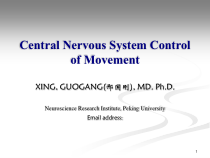 PPT
PPT
【文档说明】北大神经生物学7-1神经系统对运动的调节课件.ppt,共(56)页,3.327 MB,由小橙橙上传
转载请保留链接:https://www.ichengzhen.cn/view-243567.html
以下为本文档部分文字说明:
1CentralNervousSystemControlofMovementXING,GUOGANG(邢国刚),MD.Ph.D.NeuroscienceResearchInstitute,PekingUniversityEmailaddress:2Introduction
❖生命在于运动……❖运动是动物维系个体生存和种族繁衍的基本功能之一3Howdoesacoordinatedmovementachieved?4Thementalbodyimageseemstobegen
eratedbysomatosensory,proprioceptive,andvisualinputstotheposteriorparietalcortex(area5,area7)Abaseballpitcherplanningapitch…5◼Theh
ighestlevel-strategy➢Representedbytheassociationareasofneocortexandbasalgangliaoftheforebrain➢Isconcernedwithstrategy:
—ThegoalofthemovementandthemovementstrategythatbestachievesthegoalThemotorcontrolhierarchyhavethreelevels6◼Themidd
lelevel-tactics➢Representedbythemotorcortexandcerebellum➢Isconcernedwithtactics—Thesequencesofmusclecontractions•Arrangedi
nspaceandtime•RequiredtosmoothlyandaccuratelyachievethestrategicgoalThemotorcontrolhierarchyhavethreelevels7◼Thelowestlevel-execution➢Representedbyt
hebrainstemandspinalcord➢Isconcernedwithexecution—Actionofthemotorneuronandinterneuronpoolsthatgeneratethegoal-directedmovementand
makeanynecessaryadjustmentsofpostureThemotorcontrolhierarchyhavethreelevels8Overview◼脊髓内的“下运动神经元(Lowerneurons)”,除了受到脊髓内局部环路的影响外,还受到大脑皮层运动区及脑干中许多“上
运动神经元(Upperneurons)”的支配和协调◼基底神经节和小脑则向那些上运动神经元提供某种感觉、认知或感性的信息,使运动更加精确和协调910SensorimotorcortexBasalgangliaCerebellumBrainste
mSpinalcordInterneuron-MotorneuronMotorunit(finalcommonpathway)Receptorsmuscle,skin,joint12345❖Theseprogramsareaccessed,executed,andmodifiedbyde
scendingcommandsfromthebrain➢Thebrain’scommandandcontrolofthemotorprogramsinthespinalcord❖Themotorsystemconsistsofallourmusclesan
dtheneuronsthatcommandthem❖Thespinalcordcontainscertainmotorprogramsforthegenerationofcoordinatedmovements❖Th
emotorcontrolcanbedividedintotwoparts:➢Thespinalcord’scommandandcontrolofcoordinatedmusclecontraction11Part1SpinalControlofMovement12In
troduction❖“runningaroundlikeachickenwithitsheadcutoff”❖Therhythmicmovementscouldbeelicitedinthehindlegsof
catsanddogslongaftertheirspinalcordshadbeenseveredfromtherestofthecentralnervoussystem–CharlesSherington&GrahamBrown
(English)—Theimportanceofcircuitrywithinthespinalcordforthecoordinatedcontrolofmovements13Spinalcircuitrycontrolofmovement14Spinalm
otorneurons◼AlphamotorneuronsInnervateskeletalmuscle(extrafusalmuscle)Function:directlycommandmuscleco
ntract◼GammamotorneuronsInnervatemusclespindle(intrafusalmuscle)Function:regulatingthemusclespindle◼InterneuronsAllowscoordinat
edmotorprogramstobegenerated▪Finalcommonpathway(directlycommandmusclecontract)•Compare:UppermotorneuronsLowermotorneurons15TheLowerMo
torNeurons-Alphamotorneurons◼Alphamotorneuronsaredirectlyresponsibleforthegenerationofforcebymuscle◼Motorunit:onealphamotorneuronand
allofthemusclefibersitinnervatescollectivelymakeupmotorunit,theelementarycomponentofmotorcontrol◼Motorneuronpool:Thecollectionofalpha
motorneuronsthatinnervatesasinglemuscle16ThemotorunitisanalphamotorneuronandallofthemuscleAmotorunitand
motorneuronpoolThemotorneuronpoolisallofthealphamotorneuronsthatinnervateonemuscle17Muscleinnervationbylowermotorneurons30mixedspinalner
vescervical1-8thoracic1-12lumbar1-5sacral1-5TheventralhornofthespinalcordcontainsmotorneuronsthatinnervateskeletalmusclefibersVentral
roots+Dorsalroot=Spinalnerve18ThecervicalenlargementofthespinalcordcontainsthemotorneuronsthatinnervatethearmmusclesThelumbarenlargeme
ntcontainsneuronsthatinnervatethemusclesoftheleg支配上肢的神经元集群位于颈膨大处,支配下肢的则在腰膨大处Thedistributionofmotorneuronsinthes
pinalcordThemotorneuronsthatinnervatedistalandproximalmusculaturearefoundmainlyinthecervicalandlumbar-sacralsegm
entsofthespinalcordWhereasthoseinnervatingaxialmusculaturearefoundatalllevelsSegmentsC3-T1haveaswollenventralhornthatinnervateskeletalmusculatureina
rmsSegmentsL1-S3haveaswollenventralhornthatinnervateskeletalmusculatureinlegs19Motorneuronscontrollingflexorsliedorsaltothosecontrollin
gextensorsMotorneuronscontrollingaxialmusclesliemedialtothosecontrollingdistalmuscles支配躯干部肌肉的神经元位于脊髓前角灰质最内侧,由此向外排列的神经元则支配肢体由近及远
分布的肌肉Thedistributionoflowermotorneuronsintheventralhorn20◼Muscleweaknessandparalysis-所支配的骨骼肌瘫痪、肌张力下降、腱反射消失(软瘫)◼肌萎缩、纤维颤动或
肌束颤动◼见于如肌萎缩侧索硬化症(amyotrophiclateralsclerosis,ALS):Selectivedamagetoalphamotorneurons(degeneration)-脊髓-运动神经元的进行性溃变为主下运动神经
元的损伤表现21LouGehrigFarewellSpeech:"Fans,forthepasttwoweeksyouhavebeenreadingaboutthebadbreakIgot.YettodayIconsidermyselftheluckiest
manonthefaceofthisearth.……SoIcloseinsayingthatImayhavehadatoughbreak,butIhaveanawfullottolivefor."LouGehring,astarbaseballplayerwi
thNewYorkYankees,whodiedofALS(amyotrophiclateralsclerosis)in193622InputstoalphamotorneuronsThisinputisimportantfortheinitia
tionandcontrolofvoluntarymovementThisinputmaybeexcitatoryorinhibitoryandispartofthecircuitrythatgeneratesthespinalmotorprogramsThis
inputprovidesfeedbackaboutmusclelength23SPINALCONTROLOFMOTORUNITSHowtheactivityofthemotorneuronisitselfcon
trolled?24ReflexReceptorEffectorSpinalMotorNeuron(center)SkinMuscleJointMusclecontractionHigherCenter•Voluntarymo
vements•Nociceptivestimulus•Stretchmuscles•Posturemaintenance25Themyotaticreflex(stretchreflex)❖Twotypesofmyotaticr
eflex-TendonreflexandmuscletonusA.Tendonreflex—快速牵拉肌腱而发生的牵张反射Clinicapplication:了解脊髓不同节段的功能状态reflexmothedCentralsitee
ffect肘反射扣击肱二头肌肌腱颈5-7肘部屈曲膝反射扣击股四头肌肌腱腰2-4小腿伸直跟腱反射扣击跟腱腰5-骶2脚向足底方向屈曲单突触反射潜伏期很短,约0.7s只够一次突触传递时间延搁26+27B.Muscletonus▪肌肉
受到缓慢而持续的牵拉而发生的收缩-使骨骼肌能保持一定的肌肉张力▪意义:维持身体的姿势(posture),而不表现明显的动作▪表现:extensor(伸肌)和flexor(屈肌)都发生肌紧张直立时,以伸
肌紧张为主,因重力作用于关节,使关节趋向弯曲,伸肌受到牵拉,引起肌紧张反射,肌紧张度增加以对抗关节屈曲因重力持续作用于关节,肌紧张也就持续发生。使直立姿势得以维持多突触反射潜伏期较长,经过多个突触传递28Musclespindles:◼Cons
istsofspecializedskeletalmusclefibers◼Inthismiddleregion,groupIasensoryaxonswraparoundthemusclefibersofthespindle◼ThespindlesandtheirassociatedIa
axons,specializedforthedetectionofchangesinmusclelength(stretch):proprioceptorsandpropriception◼Iaaxonsarethethickestmyelinatedaxonssotheyconductacti
onpotentialsveryrapidly◼Iaaxonsenterthespinalcordviathedorsalroots,branchrepeatedly,andformexcitatorysynapsesuponbothinterneuronsandal
phamotorneuronsoftheventralhornsProprioceptionfrommusclespindles❖Musclespindle是一种可感受肌肉长度变化或感受牵拉刺激的本体感受器❖梭内肌感受部装置位于中间,收
缩成分位于两端,梭内肌收缩时或牵拉梭外肌时,感受装置对牵拉敏感性增高29+30Gammamotorneurons◼Extrafusalfibersareinnervatedbyalphamotorneurons◼Intrafus
alfibersreceivetheirmotorinnervationbyanothertypeoflowermotorneuroncalledagammamotorneuron◼Gammamotorne
uronsinnervatetheintrafusalmusclefiberatthetwoendsofthemusclespindle◼Activationofthesefiberscausesacontractionofthetwopolesofthemuscles
pindle,therebypullingonthenon-contractileequatorialregionandkeepingtheIaafferentsactive31Thefunctionofgammamotorn
eurons•Activationofalphamotorneuronsshortenstheextrafusalmusclefibers.Ifthemusclespindlebecomesslack,itgoes“offtheair”andnolong
erreportsthelengthofthemuscle•Activationofgammamotorneuronscontractsthepolesofthespindle,keepingit“ontheair”32TheGammaloop◼Changingtheactivity
ofthegammamotorneuronschangesthesetpointofthemyotaticfeedbackloop◼TheGammaloop◼Gammamotorneuron→intrafusalmusclefiber→I
aafferent→alphamotorneuron→extrafusalmusclefibers◼Alphaandgammamotorneuronsaresimultaneouslyactivated
bydescendingcommandsfromthebrain33ProprioceptionfromGolgitendonorgans❖Golgitendonorgan◼Actslikeastraingauge,itmonitorsmuscletension,ortheforceo
fcontraction◼LocatedatthejunctionofthemuscleandthetendonandareinnervatedbygroupIbsensoryaxonsthatareslightlysmallerthantheIaaxonsi
nnervatingthemusclespindles34GolgitendonorgansrespondtoincreasedtensiononthemuscleandtransmitthisinformationtothespinalcordviatypeIbsen
soryafferents.Becausetheactivatedmuscledoesnotchangelength,theIaafferentsremainsilentinthisexample当肌肉等长收缩时,腱器官传入冲动频率,肌梭传入冲动频率不变;当肌肉等张收缩时,腱器官
传入冲动频率不变,肌梭传入冲动频率GolgitendonorganslieinseriesbetweenthemusclefibersandtheirpointsofattachmentMusclespindle
sarearrangedparalleltotheextrafusalfibers35TheIbafferentsenterthespinalcord,branchrepeatedly,andsynapseoninterne
uronsintheventralhornSomeoftheseinterneuronsforminhibitoryconnectionswiththealphamotorneuronsinnervatingthesam
emuscle.ThisisthebasisforthereversemyotaticreflexCircuitryofthereversemyotaticreflex+-Musclespindlesituatedinparallelwiththemusclefibers,Golgitendono
rgansaresituatedinseriesIaactivityfromthespindleencodesmusclelengthinformationWhileIbactivityfromtheGolgitendonorganencodesmuscletensioni
nformation腱器官是张力感受器,其传入冲动对同一肌肉运动神经元起抑制作用肌梭是长度感受器,其传入冲动对同一肌肉运动神经元起兴奋作用当肌肉被动牵拉时,二者传入冲动频率均:首先兴奋肌梭发动牵张反射,肌肉收缩,牵拉力大到一定程度,兴奋腱器官而抑制牵张反射牵张反射
的特点:反射弧简单,感受器和效应器在同一块肌肉36Significanceofthereversemyotaticreflex◼Inextremecircumstances,thisreflexarcprotectsthemusclefro
moverload◼Thenormalfunctionistoregulatemuscletensionwithinanoptimalrange➢Asmuscletensionincreases,theinhibitionofthealphamotorneuronslowsmusc
lecontraction➢Asmuscletensionfalls,theinhibitionofthealphamotorneuronisreduced,andmusclecontractionincreases◼Thistypeofpropriocep
tivefeedbackisthoughttobeparticularlyimportantfortheproperexecutionoffinemotoracts,suchasthemanipulationoffragileob
jectswiththehands,whichrequireasteadybutnottoopowerfulgrip37Spinalinterneurons◼Mostoftheinputtothealphamotorneuronscomesfrom
interneuronsofthespinalcord◼Interneuronsreceivesynapticinputfromprimarysensoryaxons,descendingaxonsfromthebrain,andcollateralsoflowermotor
neuronaxons◼Theinterneuronsarethemselvesnetworkedtogetherinawaythatallowscoordinatedmotorprogramstobegenerated
inresponsetotheirmanyinputs38Reciprocalinhibitionofflexorsandextensorsofthesamejoint+++-◼Inhibitoryin
put◼Contractionofonesetofmusclesaccompaniedbytherelaxationoftheantagonistmusclesiscalledreciprocalinhibition◼Reciprocal
inhibitionisalsousedbydescendingpathwaystoovercomethepowerfulmyotaticreflex39(A&Cfibers)◼Excitatoryinput◼Flexorreflex:use
dtowithdrawalimbfromanaversivestimulus,suchasthewithdrawalofyourfootfromthethumbtack◼Thepainfibersenteringth
espinalcordbranchprofusedlyandactivateinterneuronsinseveralspinalsegments.Thesecellseventuallyexcitethealph
amotorneuronsthatcontrolalloftheflexormusclesoftheaffectedlimb(andinhibitoryinterneuronsarealsorecruitedtoinhibitthealphasthatcontroltheextensors
)++++Circuitryofthepolysynapticflexorreflex40Circuitryofthecrossed-extensorreflexSpinalcordIpsilateralextensorsinhibitedContralateralexte
nsorsactivated(contract)Ipsilateralflexorsactivated(contract)ContralateralflexorsinhibitedIpsilateralkneejointclosesuptoremovefootfromtackContralater
alkneejointopensuptosupportgreaterweight41Thegenerationofspinalmotorprogramsforwalking◼Headlesschickens;behavior◼Acompletetransectionofacat’sspin
alcordatthemid-thoraciclevelleavesthehindlimbscapableofgeneratingcoordinatedwalkingmovements◼Whenyouwalk,y
oualternatelywithdrawandextendyourtwolegs◼Whatisthemechanismtocoordinatethetiming?◼Thiscouldbedescendi
ngcommandsfromuppermotorneurons?No!◼Thiscontrolisexertedfromwithinthespinalcord?Yes!4243Centralpatterngeneratorswithinthespinalcord◼Thecircuitf
orthecoordinatedcontrolofwalkingmustresidewithinthespinalcord◼Ingeneral,circuitsthatgiverisetorhythmic
motoractivityarecalledcentralpatterngenerators◼Howdoneuralcircuitsgeneraterhythmicpatternsofactivity?–Thesimplestpatterngenerators,a
resingleneuronswhosemembranepropertiesendowthemwithpacemakerproperties(pacemakerneurons)44Rhythmicactivityinaspinalinterneuron(Pacemakerneur
on)SomeneuronsrespondtotheactivationofNMDAreceptorswithrhythmicdepolarization(a)Intherestingstate,theNMDAreceptorchannelsandthecalciu
m-activatedpotassiumchannelsareclosed(b)GlutamatecausestheNMDAreceptorstoopen,thecellmembranetodepolarize,andCa2+ionstoenterthecell
(c)Theriseinintracellular[Ca2+]causestheCa2+-activatedpotassiumchannelstoopen.K+ionsleavetheneuron,hyperpolariz
ingthemembrane.ThehyperpolarizationallowsMg2+ionstoenterandclogtheNMDAchannel,arrestingtheflowofCa2+(d)As[Ca2+]falls,thepotassiumchannelsc
lose,resettingthemembraneforanotheroscillation45Apossiblecircuitforrhythmicalternatingactivity(walking)Walkingisinitiatedwhenaste
adyinputexcitestwointerneuronsthatconnecttothemotorneuronscontrollingtheflexorsandextensors,respectively.Theinterneuronsrespondtoacontin
uousinputbygeneratingburstsofoutputs.Theactivitiesofthetwointerneuronsalternatebecausetheyinhibiteachotherviaot
her(inhibitory)interneurons.Thus,aburstofactivityinoneinterneuronstronglyinhibitstheother(Pacemakerneuron)(Pacemakerneuron)46Part2BrainControlofMovem
ent47Howdoesthebraincommunicatewiththemotorneuronsofthespinalcord?48Overview◼来自高级中枢的下行投射对脑干和脊髓环路的运动控制主要影响随意运动和朝向目标的运动◼发出下行投射的
中枢位于脑干某些部位以及大脑皮质的运动区域◼脑干内的两个主要结构-前庭核和网状结构对维持姿势很重要◼皮质主要运动区和次要运动区(运动前区)主要对运动进行计划并使运动高效率执行,皮质的这种作用是通过对脑干内的某些高级中枢以
及脑干、脊髓中运动神经元和环路中间神经元的控制来完成的49Thedescendingspinaltractscontrolofmovement50ThedescendingspinaltractsControlpostureandunderbrainstemcontrolContolvolunta
rymovementsofthedistalmusculatureandunderdirectcorticalcontrol51(Pyramidaltract)ControlfinemovementsofthearmsandfingersTheeffectsoflateralpath
waylesions(inmonkeys)-byDonaldLawrence&HansKuypers(inthelate1960s)TheLateralPathwaysXJoinincorticosp
inaltractinthelateralcolumnofthespinalcordTerminateinthedorsolateralregionoftheventralhornsandintermedialgraymatterWheremoto
rneuronsandinterneuronscontrolthedistalmuscles,particularlyflexorsInputfromfrontalcortexX52TheVentromedialPathways◼Containfourdescendingtracts—the
vestibulospinaltract—thetectospinaltract—thepontinereticulospinaltract—themedullaryreticulospinaltract◼Oringinateint
hebrainstem◼Terminateamongthespinalinterneurons◼Controllingproximalandaxialmuscles◼Usesensoryinformationaboutbalance,bodyposition,andthevisuale
nviromenttoreflexivelymaintainbalanceandbodyposture53Thevestibulospinalandtectospinaltractskeeptheheadbalanceontheshouldersasthebodymovest
hroughspace,andtheyturntheheadinresponsetonewsensorystimuli(midbrain)RecivedirectinputfromretinaReci
veprojectionsfromvisualcortex,aswellasafferentscarringsomatosensoryandauditoryinformationConstructamapof
thewordaroundusThemotionofthefluidinthislabyrinth,whichaccompaniesmovementsofthehead,activateshaircellsthatsignalthevestibularnucleiviacranialn
erveVIIIOne:Projectsbilaterallydownthespinalcordandactivatesthecervicalspinalcircuitsthatcontrolneckandbackmusclesandg
uidheadmovementRelysensoryinformationfromthevestibularlabyrinthintheinnerearAnother:Projectsipsilaterallyasfardownasthelumbarspinal
cordIthelpsusmaintainanuprightandbalancedposturebyfacilitatingextensormotorneuronsofthelegsStimulationatonesiteinthism
apLeadtoanorientingresponsethatdirectstheheadandeyestomove…54Thepontinereticulospinaltractenhancetheantigravityreflexe
softhespinalcordByfacilitatingtheextensorsofthelowerlimbsHelpsmaintainastandingposturebyresistingtheeffectsofgravityThemedullaryreticul
ospinaltracthastheoppositeeffect:itliberatestheantigravitymusclesfromreflexcontrolActivityinbothreticulospinaltractsiscont
rolledbydescendingsignalsfromthecortexControlpostureofthetrunkandtheantigravitymusclesofthelimbs55Asummaryo
fthemajordescendingspinaltractsandtheirpointsoforiginMotorcortexdirectlyactivatesspinalmotorneuronsandliberatesthemfromreflexcontrolbycommunic
atingwiththenucleioftheventromedialpathwaysSo,thecortexiskeyforvoluntarymovementandbehaviorTheventromedialpathwaysoriginatefromseveralregionsofth
ebrainstemandparticipatemainlyinthemaintenanceofpostureandcertainreflexmovementsInitiationofavoluntarymovements,requiresinstruc
tionsthatdescendfromthemotorcortexalongthelateralpathways56ourattention
 辽公网安备 21102102000191号
辽公网安备 21102102000191号
 营业执照
营业执照